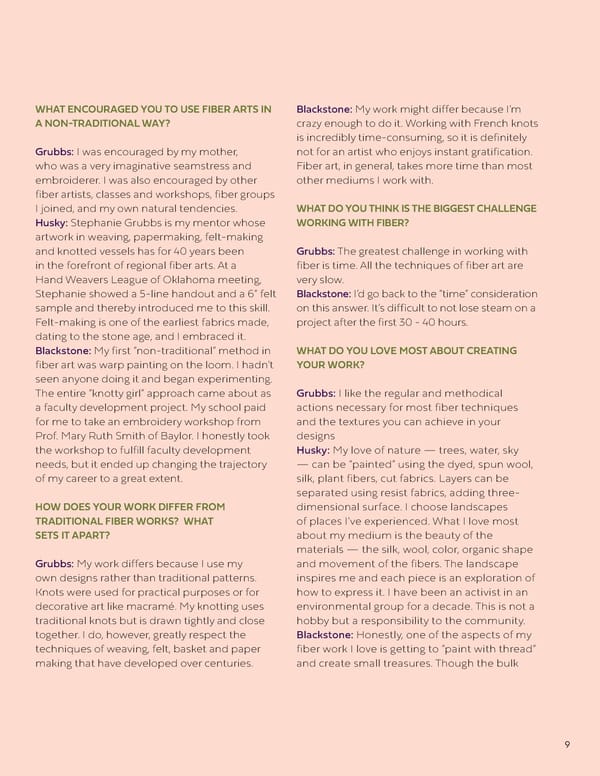WHAT ENCOURAGED YOU TO USE FIBER ARTS IN Blackstone: My work might differ because I’m - A NON TRADITIONAL WAY? crazy enough to do it. Working with French knots is incredibly time-consuming, so it is definitely Grubbs: I was encouraged by my mother, not for an artist who enjoys instant gratification. who was a very imaginative seamstress and Fiber art, in general, takes more time than most embroiderer. I was also encouraged by other other mediums I work with. fiber artists, classes and workshops, fiber groups I joined, and my own natural tendencies. WHAT DO YOU THINK IS THE BIGGEST CHALLENGE Husky: Stephanie Grubbs is my mentor whose WORKING WITH FIBER? artwork in weaving, papermaking, felt-making and knotted vessels has for 40 years been Grubbs: The greatest challenge in working with in the forefront of regional fiber arts. At a fiber is time. All the techniques of fiber art are Hand Weavers League of Oklahoma meeting, very slow. Stephanie showed a 5-line handout and a 6” felt Blackstone: I’d go back to the “time” consideration sample and thereby introduced me to this skill. on this answer. It’s difficult to not lose steam on a Felt-making is one of the earliest fabrics made, project after the first 30 - 40 hours. dating to the stone age, and I embraced it. Blackstone: My first “non-traditional” method in WHAT DO YOU LOVE MOST ABOUT CREATING fiber art was warp painting on the loom. I hadn’t YOUR WORK? seen anyone doing it and began experimenting. The entire “knotty girl” approach came about as Grubbs: I like the regular and methodical a faculty development project. My school paid actions necessary for most fiber techniques for me to take an embroidery workshop from and the textures you can achieve in your Prof. Mary Ruth Smith of Baylor. I honestly took designs the workshop to fulfill faculty development Husky: My love of nature — trees, water, sky needs, but it ended up changing the trajectory — can be “painted” using the dyed, spun wool, of my career to a great extent. silk, plant fibers, cut fabrics. Layers can be separated using resist fabrics, adding three- HOW DOES YOUR WORK DIFFER FROM dimensional surface. I choose landscapes TRADITIONAL FIBER WORKS? WHAT of places I’ve experienced. What I love most SETS IT APART? about my medium is the beauty of the materials — the silk, wool, color, organic shape Grubbs: My work differs because I use my and movement of the fibers. The landscape own designs rather than traditional patterns. inspires me and each piece is an exploration of Knots were used for practical purposes or for how to express it. I have been an activist in an decorative art like macramé. My knotting uses environmental group for a decade. This is not a traditional knots but is drawn tightly and close hobby but a responsibility to the community. together. I do, however, greatly respect the Blackstone: Honestly, one of the aspects of my techniques of weaving, felt, basket and paper fiber work I love is getting to “paint with thread” making that have developed over centuries. and create small treasures. Though the bulk 9
 June 2021 Oklahoma Hall of Fame Magazine Page 10 Page 12
June 2021 Oklahoma Hall of Fame Magazine Page 10 Page 12